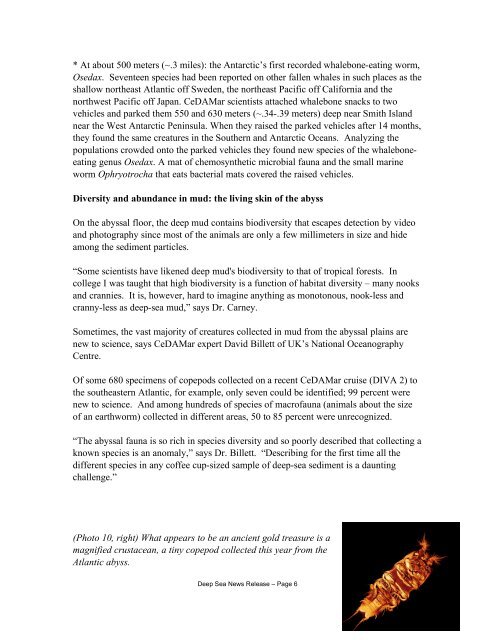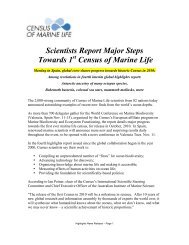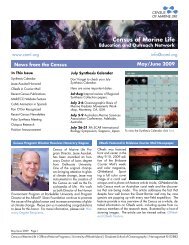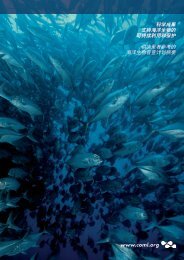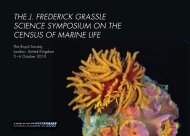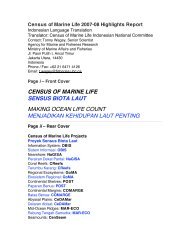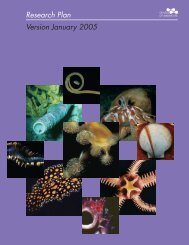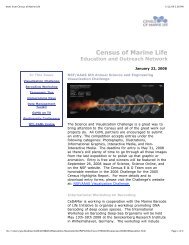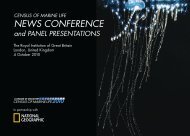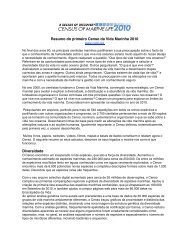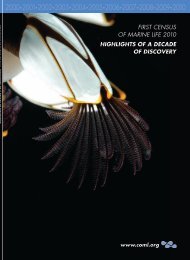From the Edge of Darkness to the Black Abyss - Census of Marine Life
From the Edge of Darkness to the Black Abyss - Census of Marine Life
From the Edge of Darkness to the Black Abyss - Census of Marine Life
Create successful ePaper yourself
Turn your PDF publications into a flip-book with our unique Google optimized e-Paper software.
* At about 500 meters (~.3 miles): <strong>the</strong> Antarctic’s first recorded whalebone-eating worm,Osedax. Seventeen species had been reported on o<strong>the</strong>r fallen whales in such places as <strong>the</strong>shallow nor<strong>the</strong>ast Atlantic <strong>of</strong>f Sweden, <strong>the</strong> nor<strong>the</strong>ast Pacific <strong>of</strong>f California and <strong>the</strong>northwest Pacific <strong>of</strong>f Japan. CeDAMar scientists attached whalebone snacks <strong>to</strong> twovehicles and parked <strong>the</strong>m 550 and 630 meters (~.34-.39 meters) deep near Smith Islandnear <strong>the</strong> West Antarctic Peninsula. When <strong>the</strong>y raised <strong>the</strong> parked vehicles after 14 months,<strong>the</strong>y found <strong>the</strong> same creatures in <strong>the</strong> Sou<strong>the</strong>rn and Antarctic Oceans. Analyzing <strong>the</strong>populations crowded on<strong>to</strong> <strong>the</strong> parked vehicles <strong>the</strong>y found new species <strong>of</strong> <strong>the</strong> whaleboneeatinggenus Osedax. A mat <strong>of</strong> chemosyn<strong>the</strong>tic microbial fauna and <strong>the</strong> small marineworm Ophryotrocha that eats bacterial mats covered <strong>the</strong> raised vehicles.Diversity and abundance in mud: <strong>the</strong> living skin <strong>of</strong> <strong>the</strong> abyssOn <strong>the</strong> abyssal floor, <strong>the</strong> deep mud contains biodiversity that escapes detection by videoand pho<strong>to</strong>graphy since most <strong>of</strong> <strong>the</strong> animals are only a few millimeters in size and hideamong <strong>the</strong> sediment particles.“Some scientists have likened deep mud's biodiversity <strong>to</strong> that <strong>of</strong> tropical forests. Incollege I was taught that high biodiversity is a function <strong>of</strong> habitat diversity – many nooksand crannies. It is, however, hard <strong>to</strong> imagine anything as mono<strong>to</strong>nous, nook-less andcranny-less as deep-sea mud,” says Dr. Carney.Sometimes, <strong>the</strong> vast majority <strong>of</strong> creatures collected in mud from <strong>the</strong> abyssal plains arenew <strong>to</strong> science, says CeDAMar expert David Billett <strong>of</strong> UK’s National OceanographyCentre.Of some 680 specimens <strong>of</strong> copepods collected on a recent CeDAMar cruise (DIVA 2) <strong>to</strong><strong>the</strong> sou<strong>the</strong>astern Atlantic, for example, only seven could be identified; 99 percent werenew <strong>to</strong> science. And among hundreds <strong>of</strong> species <strong>of</strong> macr<strong>of</strong>auna (animals about <strong>the</strong> size<strong>of</strong> an earthworm) collected in different areas, 50 <strong>to</strong> 85 percent were unrecognized.“The abyssal fauna is so rich in species diversity and so poorly described that collecting aknown species is an anomaly,” says Dr. Billett. “Describing for <strong>the</strong> first time all <strong>the</strong>different species in any c<strong>of</strong>fee cup-sized sample <strong>of</strong> deep-sea sediment is a dauntingchallenge.”(Pho<strong>to</strong> 10, right) What appears <strong>to</strong> be an ancient gold treasure is amagnified crustacean, a tiny copepod collected this year from <strong>the</strong>Atlantic abyss.Deep Sea News Release – Page 6


